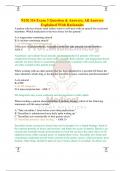NUR 316 Exam 3 Question & Answers, All Answers
Explained With Rationales
A patient who has chronic renal failure wants to self-treat with an antacid for occasional
heartburn. Which medication is the best choice for this patient?
A.A magnesium-containing antacid
B.A calcium-containing antacid
C.An aluminum-containing antacid
D.Because of renal problems, the patient should not take antacids for this problem. -
ANS: C
Aluminum- and sodium-based antacids are recommended for patients with renal
compromise because they are more easily excreted. Both calcium- and magnesium-based
antacids are more likely to accumulate to toxic levels in patients with renal disease and
are often avoided in this patient group.
When working with an older patient who has been admitted for a possible GI bleed, the
nurse identifies which drug as having the potential to cause confusion and disorientation?
A.An antacid
B.A PPI
C.An H2 antagonist
D.A mucosal protectant - ANS: C
H2 antagonists may cause confusion and disorientation in older adults.
When teaching a patient about sucralfate (Carafate) therapy, which of the following
statements will the nurse include?
A."Take sucralfate 1 hour before your other medications."
B."Sucralfate is administered once daily upon waking up."
C."Sucralfate acts systemically to heal gastric ulcers."
D."Sucralfate promotes ulcer healing." - ANS: D
Sucralfate forms a protective barrier that can be thought of as a liquid bandage, binds to
the exposed proteins of ulcers and erosions, and limits the access of pepsin. Pepsin is an
enzyme that normally breaks down proteins in food but can have the same effect on GI
epithelial tissue, either causing ulcers or making them worse. Sucralfate also binds and
concentrates epidermal growth factor, present in the gastric tissues, which promotes ulcer
healing. Other drugs should be taken at least 2 hours ahead of sucralfate. Its effects are
,transient and multiple daily dosing (up to four times daily) is therefore needed. Sucralfate
acts locally, not systemically, binding directly to the surface of an ulcer.
Simethicone (Mylicon) is often combined with calcium carbonate antacids because of
what effect?
A.An increased antacid effect will result when these drugs are given in combination.
B.Simethicone helps to reduce the gas that is caused by the calcium antacids.
C.Simethicone reduces the diarrhea that is caused by the calcium.
D.Simethicone improves the taste of the calcium tablets, which must be chewed. - ANS:
B
Calcium carbonate neutralization will produce gas and possibly belching, so the addition
of simethicone is intended to reduce this effect. Simethicone alters elasticity of mucus-
coated gas bubbles, breaking them into smaller ones, resulting in decreased gas pain and
increased expulsion via mouth or rectum.
The antidiarrheal drug Lomotil contains both diphenoxylate, a synthetic opiate agonist,
and atropine, an anticholinergic. What is the purpose of the additive, atropine?
A.Enhance the effects of the diphenoxylate.
B.Discourage recreational use of the opiate diphenoxylate.
C.Counteract the adverse effects of the diphenoxylate.
D.Act as an adsorbent for bacteria in the bowel. - ANS: B
A small dose of atropine, combined with diphenoxylate, discourages recreational use of
this drug because if taken in large doses, a person will experience unpleasant
anticholinergic effects such as dry mouth, abdominal pain, blurred vision, and
tachycardia.
A patient is experiencing diarrhea while completing a course of antibiotic therapy. Which
of the following agents does the nurse anticipate administering to the patient?
A.L. acidophilus
B.Bismuth subsalicylate
C.Diphenoxylate with atropine
D.Loperamide - ANS: A
L. acidophilus is a probiotic often used in the treatment of antibiotic-induced diarrhea.
The other agents are usually not used in the treatment of antibiotic-induced diarrhea.
, A patient who takes warfarin has been prescribed an adsorbent for diarrhea. It is
important for the nurse to assess the patient for bruising because use of warfarin with
adsorbents interferes with the absorption of which vitamin?
A.A
B.D
C.E
D.K - ANS: D
The oral anticoagulant warfarin is more likely to cause increased bleeding times or
bruising when co-administered with adsorbents. This is thought to be because the
adsorbents bind to vitamin K, which is needed to make certain clotting factors. Vitamin K
is synthesized by the normal bacterial flora in the bowel.
Before administering belladonna alkaloids, it is most important for the nurse to assess the
patient for a history of which condition?
A.Anemia
B.Diabetes mellitus
C.Myasthenia gravis
D.Hypertension - ANS: C
Use of the belladonna alkaloid preparations is contraindicated in patients who have
shown a hypersensitivity to anticholinergics and in patients with narrow-angle glaucoma,
GI obstruction, myasthenia gravis, paralytic ileus, and toxic megacolon.
Which antidiarrheal does the nurse associate with the development of adverse effects of
urinary retention, headache, confusion, dry skin, rash, and blurred vision?
A.Anticholinergics
B.Adsorbents
C.Probiotics
D.Opiates - ANS: A
Anticholinergics work by decreasing GI peristalsis through their parasympathetic
blocking effects. Adverse effects include urinary retention, headache, confusion, dry skin,
rash, and blurred vision.
A patient is taking lactulose four times a day but does not have a history of constipation.
In fact, he has had bowel movements every day. What is the probable reason for the
lactulose?
A.Cleansing the bowel before a procedure
B.Removal of helminths




